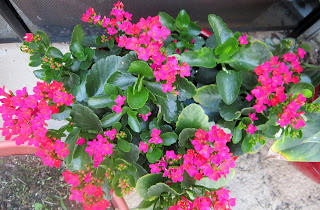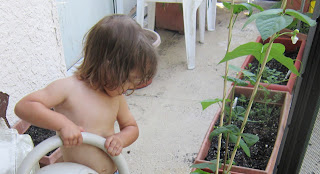 |
| Curcuma Ginger Returns 4/1/2012 |
 |
| Curcuma Ginger in Flower 2011 |
Curcuma Ginger is also known as the Siam Tulip or its Latin name of Curcuma petiolata and goes dormant from November to the spring of every year. I read May or June but my Curcuma is just coming round now as you can see in the photo. I've been watering it along with my other plants and trying to keep it weeded (for the most part unsuccessfully). This plant is fragrant as all gingers are and is hardy from zone 7a/b to zone 11. I don't want you to tune out if you are in a cooler zone than this. This is a perfect plant for you in the warmer climes in the summer time. It is great out on the deck in a container and then as the weather cools off you can bring it inside in a southern window. Since it's dormant from November to May, you won't be missing anything. You can keep it as a houseplant and treat it like one of your bulbs. I'm going to point you to a website that gives you some houseplant tips for this plant. In fact, I keep this in a container on my lanai as well, I just never bring it inside. During frost season, I bring it closer to the house for some added protection. The Siam Tulip has average watering needs but is drought tolerant. This means is a good xeriscaping plant. I've read that it should be both full sun and partial shade to full shade (lol). I keep mine on the lanai which is full sun but under the screen. When I used my handy dandy sun measuring tool, it tells me it is partial shade. It seems to me that there is a lot of different advice about caring for this plant, so I'd say use your best judgement from what you read. I went by the seat of my pants and did just fine. Fertilize this little sweetheart in the spring with 10-20-10 mixture and you can divide the rhizomes in the spring for propagation as well. You can also gather the seeds by allowing the pods to mature and dry on the plant first and then breaking them open to gather the seeds. I've never tried the seed gathering, but I'm thinking I might this year.
 |
| kalanchoe blossfeldiana
|
My Kalanchoes are in their second flowers for the year. It has been a strange year. They flowered through the entire winter because it was so mild. About a month or so ago, I cut them way back because they looked so straggly and added a bunch of fresh soil and some all purpose time-released fertilizer. As you can see above, we have some new blossoms coming. Kalanchoes have never really been on my list of favorite flowers for a weird reason from my childhood. My mom had them lining the front walk to the front door. The bees love these flowers. I had gotten a really bad sunburn and had open blisters all over my arms. I have a memory of the bees and the open blisters and these flowers. So, until last year, I refused to have these plants. You'll never guess where I put them. lol I moved them to the lanai after I realized my error. They got a bit neglected until I moved them to the lanai. The patio or lanai is where I spend the bulk of my time.
So let's talk a bit about kalanchoes and what they need. Kalanchoes originated in Madagascar and need temperatures between 60 F and 85 F. Since they are succulents, they are drought tolerant but if you let it dry out completely, it will wither and it will take a while for it to come back. They need bright light, so a shady location is not the best place for it. Too much sunlight and it will grow a lot but reduce its blossoms. This is probably why it's doing so well on my lanai. The insects it is prone to are aphids, scale, spider mites and nematodes. These are simple to propagate. Just cut a stem that's 4 - 6 inches and remove the lower leaves and stick it about 1/2 way into the soil and water like it already has roots and is a plant every 2 -3 days. It should take root and start a new plant that you can share with a friend. Probably the most important thing to remember with your kalanchoe is to never let the temperature fall below 40 F. Bring it inside if it's going to get that cold to protect the plant. Otherwise, it's a stalwart little soldier of a flower.
Today's Links:
Curcuma Ginger Sites:
Kalanchoe sites:


 The Lemon Lime tree had a lot of trouble. I sprayed it several days with my homemade white oil using my new sprayer since the old sprayer crapped out finally. I ended up with more oil on me than on the tree. I sprayed both trees to be on the safe side. Today, I did a little inspection and while I saw a couple of ants on the tree, the ants were not moving. It was not the ant parade I saw a few weeks ago. I also had a nice surprise of a nice sized piece of fruit that did not fall off and two new flowers beginning.
The Lemon Lime tree had a lot of trouble. I sprayed it several days with my homemade white oil using my new sprayer since the old sprayer crapped out finally. I ended up with more oil on me than on the tree. I sprayed both trees to be on the safe side. Today, I did a little inspection and while I saw a couple of ants on the tree, the ants were not moving. It was not the ant parade I saw a few weeks ago. I also had a nice surprise of a nice sized piece of fruit that did not fall off and two new flowers beginning.


















.JPG)
.JPG)







